This post contains affiliate links (I get a commission at no extra cost to you for purchases made through links in this post).
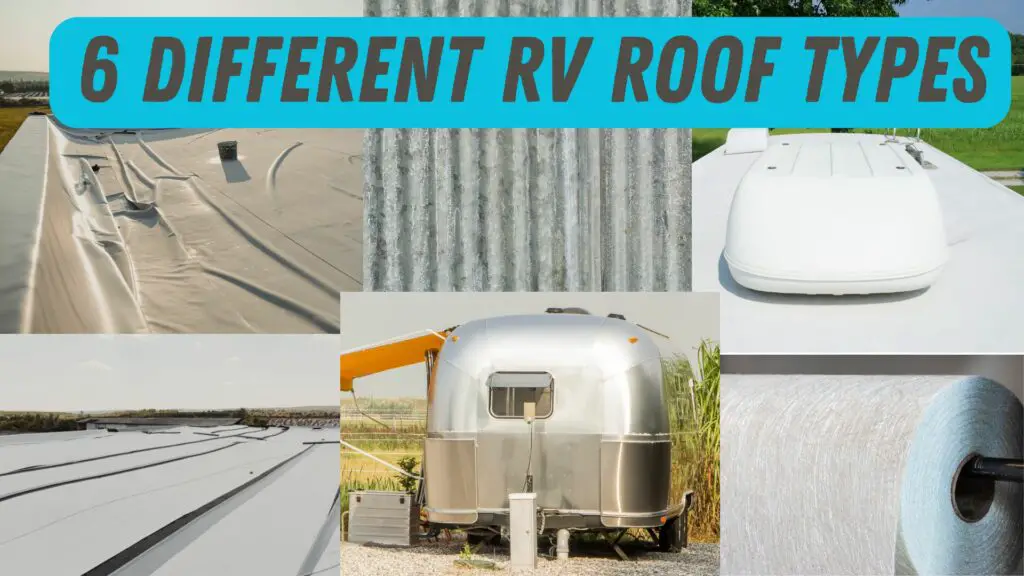
Whether you live in a camper van, a recreation vehicle, a suited-up school bus, or a camper, your vehicle likely has a roof. The type of roof you have determines what kind of maintenance you need for your vehicle and even what kind of products you can use.
There are six different types of RV roofs, aluminum, TPO rubber, EPDM rubber, fiberglass, vinyl (PVC), and galvanized metal. It’s important to know the difference as maintenance and compatible products vary; In this article, I will teach you how to tell the difference between them based on how they look.
Below, I’ll start by going through the main distinctions between the different RV roofs. After that, I will go more in-depth about the different roof types, what differs, and what products you can use, as well as more ways of telling them apart if you are still unsure which you have after the infographic just below.
How To Tell Different Types of RV Roofs Apart
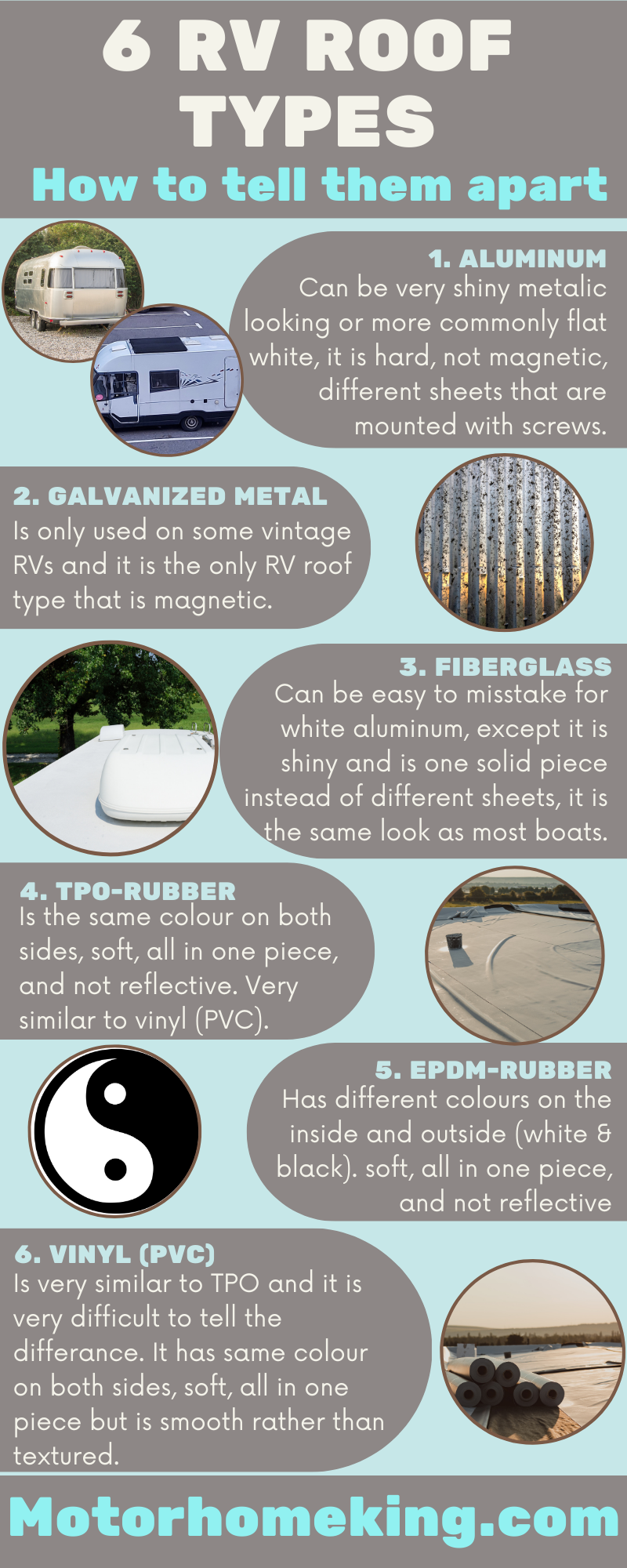
The easiest way to figure out what kind of roofing you have is, in most cases, to check your manual. There should be a description in your handbook, manual, or the paperwork you received with information about not only your roof type but also the warranty offered to you by the dealership.
If you got your RV secondhand or lost your materials, any RV repair shop should be able to give you more insight, too. But luckily, you can usually tell by looking at your roof what it is made of, and if you are still unsure after the infographic above, I will dive a bit deeper here below.
Let’s start with one of the easiest distinctions between rubber and metal. Is your roof soft, all in one piece, and not reflective? If so, it is likely to be rubber or vinyl! Is your roof metallic or shiny, hard, and in multiple panels? If so, it is likely metal! Now let’s dive into what kind as well as more about them!
1. Aluminum RV Roofs
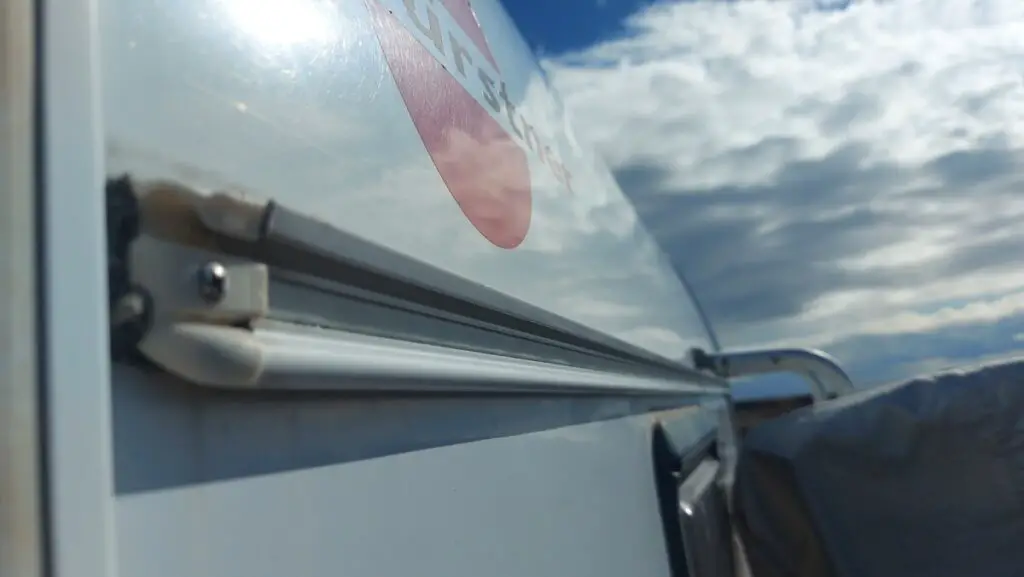
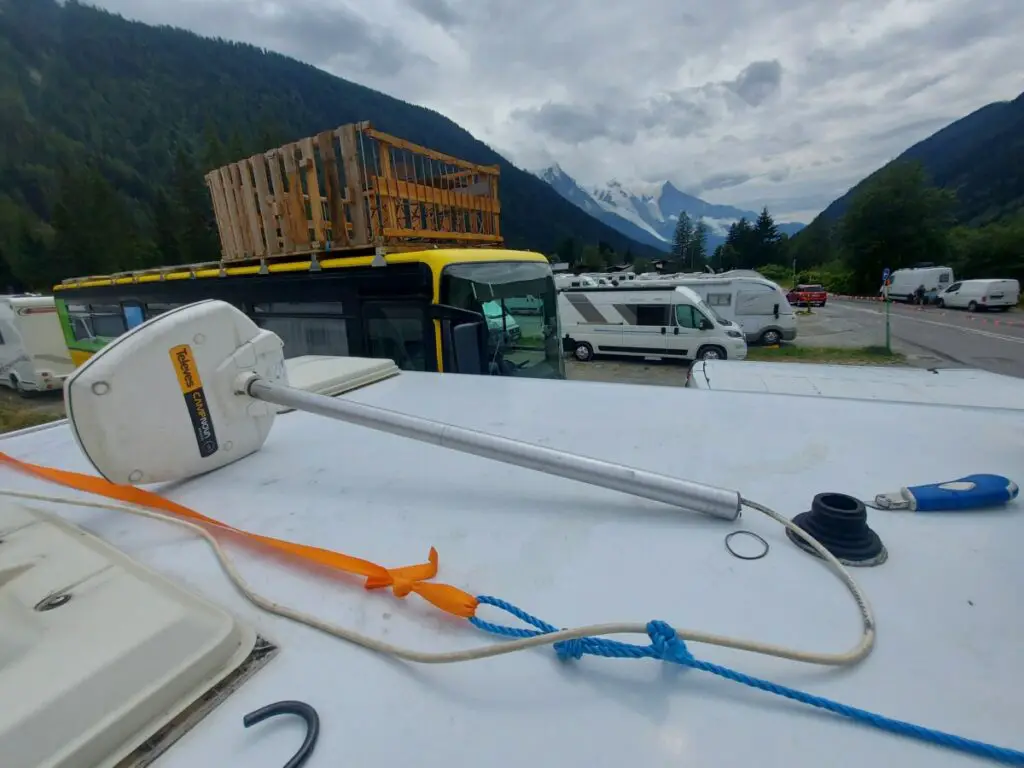

Aluminum is a great building material and doesn’t rust like other metals, which is why planes are made of aluminum.
Because it has a metallic characteristic, as the rest of your RV likely does, you will need to clean the roof pretty often. It’ll build up with debris and dirt, just like the sides of your car when on trips.
Additionally, you will often need to seal your aluminum roof with a sealant. This ensures that you won’t get any of those dreaded leaks. Aluminum roofs last a while, and you can expect yours to last at least 20 years before it needs a full replacement or a rehaul.
My RV aluminum roof have lasted 26 years by now, there are a couple of dents and scratches, it is time for a proper reseal of the whole roof and some protective coating but all in all it still looks good and im sure it will last another 26 years with the proper maintenance.
Pros of Aluminum Roofs
Here are a few benefits you should be aware of with aluminum roofs:
- Aluminum roofs are more durable than rubber roofs.
- Aluminum roofs are easier to repair/replace (there are more materials and mechanics available familiar with this type of roof).
- Aluminum roofs hold heavy accessories, such as fans or generators, with great stability.
- Aluminum roofs are more fire-resistant compared to rubber roofs.
- Aluminum does not rust in the same way as other metals.
Aluminum roofs are often what you will find at the RV dealership by default.
Cons of Aluminum Roofs
Aluminum roofs aren’t perfect. They do have a few issues and common complaints. These issues include:
- Being louder than rubber roofs during the rain.
- Need more maintenance.
- Conducting heat.
- Needing more thorough cleaning.
- Heavy, adding some weight that affects your fuel mileage.
- Rather than rust, aluminum does erode.
Now, depending on where you camp, some of these cons may be pros–most notably the heat-conducting nature of aluminum if you like to camp off-season in the frigid wilderness. Regardless, there are some cons you should consider!
Aluminum RV roof – How to tell that you have one
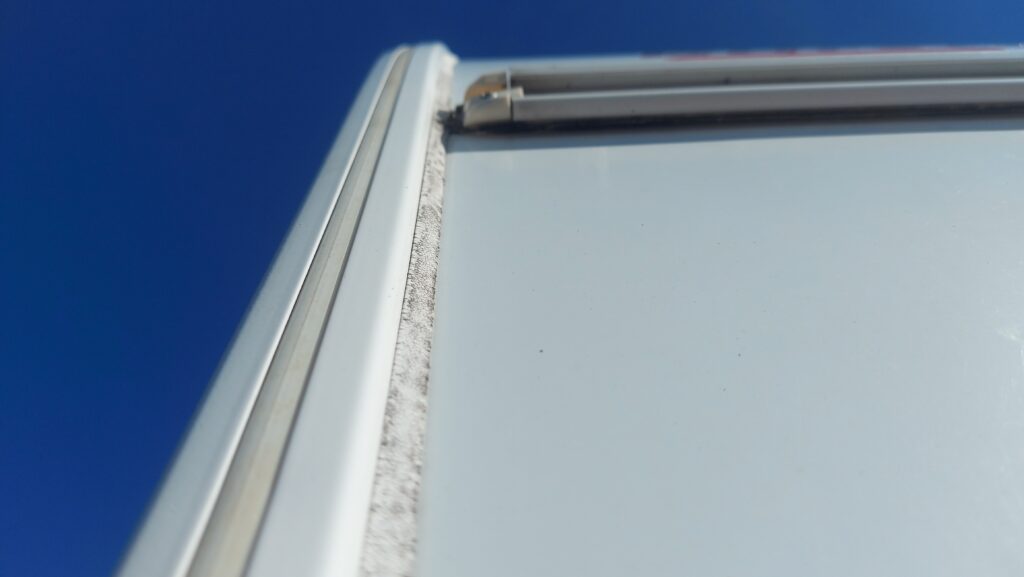
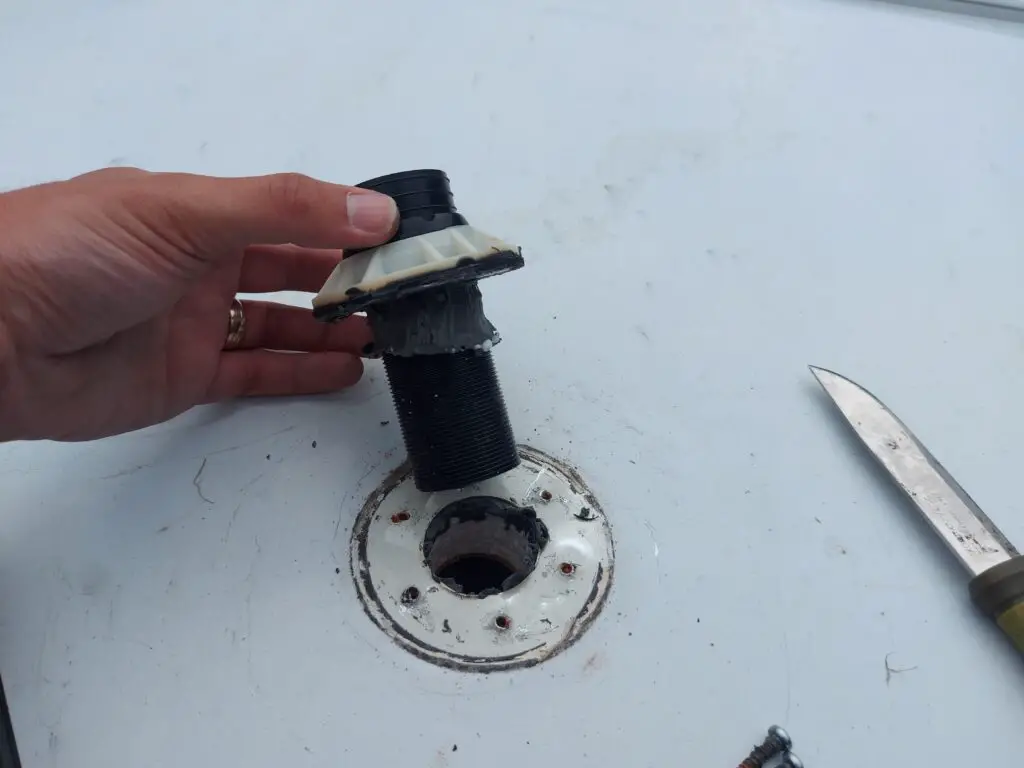
Aluminum RV roofs can be very shiny metallic looking, like an old airstream trailer, or, nowadays, more commonly, flat white. It is hard, not magnetic, and in different sheets that are mounted with screws.
I have an aluminum roof on my RV, which is the one you will see some pictures of both above and below.

Aluminum as a building material is more similar to metal rather than the aluminum foil that you use in the kitchen. It will look thick and shiny in a metallic fashion. Although it is a very thin sheet, it is usually white, and when it is white, it is dull or flat white rather than shiny.
Typically, you will also see that an aluminum roof is screwed onto the top of your RV with hardware. Unlike rubber or fiberglass, which has an almost seamless look, you will see exactly where your aluminum sticks to your roof via hardware.
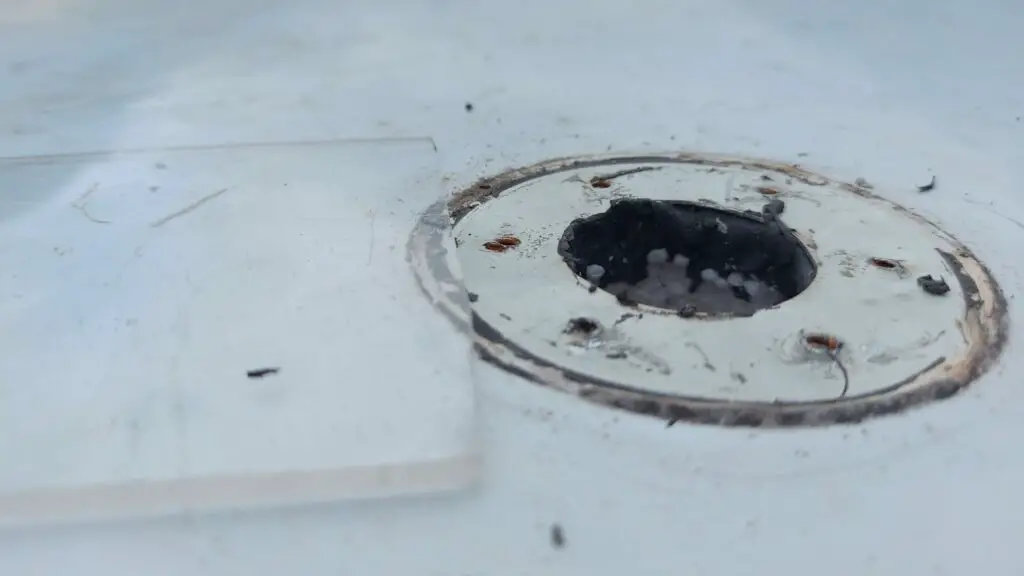
This was a picture of my RV roof when I removed the mount for a TV antenna, and there you can easily see that it is a thin sheet of aluminum rather than the other materials.
Aluminum roofs also come in multiple panels, so if you need to repair something, you don’t have to remove your entire roof. This is unlike rubber roofs, which are all in one piece.
Products To Use With Aluminum RV Roofs
| Main Application | Brand – Name With Amazon Affiliate Link | Works on Aluminum |
|---|---|---|
| Secondary Seal Horizontal Surface (Roof) | Dicor 501 Self-Leveling Lap Sealant | YES |
| Secondary Seal Vertical Surface (Walls) | Dicor 551 Non-Leveling Lap Sealant | YES |
| Roof Coating (Protective Paint) | AMES Maximum Stretch Roof Coating | YES |
| Sealant (caulking sealant) | Sikaflex 221 sealant | YES |
| Mounting Adhesive | Sikaflex 252 Adhesive | YES |
| Sealant Tape For Emergency (or on top of slide-outs) | Eternabond tape 4″x25′ | YES |
| Butyl Tape (Sealant in between objects, like between window frame and the roof or wall). | Dicor Butyl seal tape | YES |
If you have an aluminum roof, you will likely notice that most RV dealerships and shops have everything you need to maintain it, although they might not have the best brands in the store. In the table above, I have gathered my favorite products that are compatible with aluminum RV roofs.
2. Galvanized Metal RV Roofs

You will most commonly find galvanized metal roofs on vintage trailers, as this isn’t a method commonly used anymore. It is easy to mix up with aluminum, as both could look similar and feel the same on top of your RV.
You can use similar products for both, but if there’s a chance your RV is old enough to have a galvanized metal roof–we’re talking vintage-era RVs and trailers–then you should double-check the material. I have it listed in this article because while it is rare, some RV owners out there have it!
Pros of Galvanized Metal RV Roofs
For a galvanized metal roof, you can expect the following:
- A more vintage look.
- A unique aesthetic.
Cons of Galvanized Metal RV Roofs
Galvanized metal roofs are rare now and are typically a DIY project some older RV owners might have undertaken to protect their vehicles.
For this reason, you might experience the following problems:
- Difficulty standing on the roof to make repairs
- Difficulty adding accessories
- Easily rusting material
Additionally, many Vintage Vehicle forums have comments and questions about products to use with a galvanized roof and maintenance. Often, these are answered: “It would be cheaper just to get a new roof altogether.” Although most products that you can use on an aluminum RV roof, you can use on galvanized metal as well.
Galvanized metal RV roof – How to tell that you have one

Galvanized metal Is only used on some vintage RVs, and it is the only RV roof type that is magnetic, so if you think you might have a galvanized RV roof, you can bring a magnet and check if it is magnetic. Otherwise, galvanized metal has a very distinct look, sort of many different metallic colors.
So it should be fairly easy to distinguish whether or not your RV has a galvanized roof.
Products To Use With Galvanized Metal RV Roofs
Luckily, all my favorite RV roof products that I use and recommend for aluminum roofs also say in the description that they work on metal surfaces as well! So here comes a table of some of the main products you might want to use on your RV roof.
| Main Application | Brand – Name With Amazon Affiliate Link | Works on Metal |
|---|---|---|
| Secondary Seal Horizontal Surface (Roof) | Dicor 501 Self-Leveling Lap Sealant | YES |
| Secondary Seal Vertical Surface (Walls) | Dicor 551 Non-Leveling Lap Sealant | YES |
| Roof Coating (Protective Paint) | AMES Maximum Stretch Roof Coating | YES |
| Sealant (caulking sealant) | Sikaflex 221 sealant | YES |
| Mounting Adhesive | Sikaflex 252 Adhesive | YES |
| Sealant Tape For Emergency (or on top of slide-outs) | Eternabond tape 4″x25′ | YES |
| Butyl Tape (Sealant in between objects, like between window frame and the roof or wall). | Dicor Butyl seal tape | YES |
If there is another product you are looking into getting, ensure it says that it can be used on metal. If you are still wondering, remember that your local RV dealer should be able to help you determine if a product is safe to use with your metal roof! And you can also send me an e-mail or comment on the article.
3. Fiberglass RV Roofs

If you are looking for a roof that is lightweight and durable, fiberglass is the way to go. Fiberglass roofs are often used on RVs and other adventure vehicles like boats.
Fiberglass roofs need to be properly maintained and washed often. Still, they aren’t as troublesome regarding leaks as they don’t have as many panels as an aluminum or metal roof. Additionally, the durability and thickness make sounds less harsh on the top of your RV.
Pros of Fiberglass RV Roofs
Fiberglass roofs are pretty popular for luxury RVs, and this is because:
- Fiberglass RV roofs are typically more durable
- Fiberglass RV roofs are relatively heavy, which also makes them more durable
- Fiberglass RV roofs are quiet in comparison to aluminum roofs
- Fiberglass RV roofs are crack resistant
- Fiberglass won’t rust
Fiberglass roofs can definitely make your RV a safe one to sleep in!
Cons of Fiberglass RV Roofs
I said they were luxury for a reason. The difficulty with a fiberglass roof is that it is often more expensive than an aluminum or vinyl roof. A fiberglass roof has that extra durability if you are willing to pay for it! You definitely get what you pay for, though.
Fiberglass RV roof – How to tell that you have one
It can be easy to mistake a fiberglass RV roof for white aluminum, except it is shinier and in one solid piece instead of different sheets. It has the same look as most boats, so if you have seen a white boat that reminds you of plastic, likely, it was also made from fiberglass.
Fiberglass can be found on many RVs today—it is a popular choice because it is durable. It looks very similar to metal, and only a keen eye can tell the difference. Fiberglass is made of resin and glass fibers, giving it a more noticeable shine than metal; it is also very hard and won’t bend as a thin aluminum sheet could.
Products To Use With Fiberglass RV Roofs
In the table below, I have gathered some of the most popular products and some of my favorites that you can use on an RV fiberglass roof.
| Main Application | Brand, Name With Amazon Affiliate Link | Works On Fiberglass |
|---|---|---|
| Secondary Seal Horizontal Surface | Dicor 501 Self-Leveling Lap Sealant | YES |
| Secondary Seal Vertical Surface | Dicor 551 Non-Leveling Lap Sealant | YES |
| Sealant | Sikaflex 221 sealant | YES |
| RV Cleaner | 303 RV Wash & Seal – Clean | YES |
| Roof Coating | Dicor Fiberglass RV Roof Coating | YES |
| Roof Coating | Liquid Rubber RV Roof Coating | YES |
| Roof Cleaner | Dicor Rubber RV Roof Cleanser Spray | YES |
| Mounting Adhesive | Sikaflex 252 Adhesive | YES |
| Emergency Seal Tape | Eternabond tape 4″x25′ | YES |
| Butyl Seal Tape | Dicor Butyl seal tape | YES |
| Black streak remover | 303 black streak remover | YES |
4. Vinyl (PVC) RV Roofs
Vinyl is an uncommon material for RV roofs, but it is gaining popularity. It is lightweight, easy to install, and doesn’t require much maintenance. Additionally, it is pretty inexpensive. Because it is easy to work with, vinyl can be used in all shapes—even curved roofs!
PVC, or polyvinyl chloride, is most often used for roofing. You may also recognize the acronym from your plumbing–most pipes are made of PVC, too! The PVC used for roofing is even sturdier and manufactured a bit differently. That said, PVC and vinyl are sturdy, just not as sturdy as the above ones.
Pros of Vinyl RV Roofs
Vinyl is a great material for roofs. Some of the pros include:
- Flame resistance
- Water resistance
- Cost
Additionally, it lasts a pretty long time!
Cons of Vinyl RV Roofs
Vinyl is a rare roof material, so it can be difficult to find people willing to work with it. Additionally, finding materials to replace it can be tricky.
Vinyl (PVC) RV Roof – How to tell you have one
You will definitely be able to tell apart a vinyl roof and an aluminum or fiberglass roof. Vinyl is a softer material. It is almost plastic-like in texture and rubber-like in movement, though it is extremely strong. It is typically what houses use as siding, and it is becoming a more common roofing material for homes.
Vinyl (PVC) RV roofs are very similar to TPO, and it is difficult to tell the difference between them. It has the same color on both sides, is soft, and is all in one piece, but the vinyl is smooth rather than textured. It’s the same material that is used as pool liners, and some say it has a certain smell to it.
As it is so hard to tell the difference between Vinyl (PVC) roofs and TPO roofs, I would recommend you search the internet for an answer to what kind of roof your RV has, look after a manual, or call the manufacturer to ensure what type of roof you have.
Or only use products that are compatible with both vinyl and TPO Roofs.
Products To Use With Vinyl RV Roofs
Vinyl is an interesting middle ground between metal roofs and rubber roofs. For this reason, they can also typically use both product lines.
In the table below, you will find some of the most useful and popular products you could use on a vinyl RV roof.
| Main Application | Brand, Name With Amazon Affiliate Link | Works On Vinyl |
|---|---|---|
| Secondary Seal Horizontal Surface | Dicor 501 Self-Leveling Lap Sealant | YES |
| Secondary Seal Vertical Surface | Dicor 551 Non-Leveling Lap Sealant | YES |
| Sealant | Sikaflex 221 sealant | YES |
| RV Cleaner | 303 RV Wash & Seal – Clean | YES |
| Roof Coating | Liquid Rubber RV Roof Coating | YES |
| Roof Cleaner | Dicor Rubber RV Roof Cleanser Spray | YES |
| Mounting Adhesive | Sikaflex 252 Adhesive | YES |
| Emergency Seal Tape | Eternabond tape 4″x25′ | YES |
| Butyl Seal Tape | Dicor Butyl seal tape | YES |
| Black streak remover | 303 black streak remover | YES |
5. Rubber RV Roofs – EPDM & TPO
Rubber roofs are now the most popular roofs for recreational vehicles. You will typically find rubber roofs on most new RVs. It is not necessarily because it is better–but it is definitely cheaper!
There are two main types of rubber roofs: TPO and EPDM.
- TPO is a synthetic rubber that can be molded in various shapes and sizes. It is also very durable and can withstand extreme weather conditions, including rain, snow, sun, heat, and cold.
- EPDM is one of the most common materials used in RV roofs, next to TPO. It is a synthetic rubber with excellent weathering properties, but it is also very flexible and easy to install. EPDM rubber roofing is a synthetic rubber material that is durable and long-lasting.
It is self-sealing, which acts as a waterproof membrane for your RV. These characteristics make EPDM both durable and low-maintenance, so it is great for recreational vehicles that can handle the elements easily.
This roofing also resists UV damage from the sun and oxidation from rainwater, making it ideal for outdoor use in all climates.
Pros of Rubber Roofing
In general, you will find that rubber roofing is:
- More lightweight
- More affordable than other roofs
- Sleek looking
- Durable
- Energy-Efficient
TPO is also pretty UV reflective and resistant, though EPDM doesn’t do well with UV. EPDM, though, is much more durable than TPO!
Cons of Rubber Roofing
Rubber roofing isn’t all good news, though. If you have rubber roofing, you will typically need to do more maintenance and replace it more often than any other type. Rubber roofing also comes in one large piece, making it necessary to replace the whole thing if there are any issues you can’t patch up.
Additionally, rubber roofing gets dirty in a much different way. It can be more difficult to wash off rubber roofing if you don’t elect to use the right materials.
EPDM-Rubber Roof – How to tell that you have one
When you see a rubber roof, you will know. It looks just like rubber! In some cases, it may even look like a large wrap on the top of a vehicle. But to tell the different types apart can be more difficult.
EPDM rubber roofs have different colors on the inside and outside (white & black). They are soft, all in one piece, and not reflective. To learn if your roof has different colors on the inside and outside, follow the instructions from the video I found on youtube below.
TPO-Rubber RV Roof – How to tell that you have one
TPO rubber Is the same color on both sides, so if you take away the trimmings around a hatch or vent on the inside of your RV, you will usually be able to see a part of your roof, and then you can see if it has the same color on both sides or not. TPO rubber roofs are also soft, all in one piece, and not reflective.
Check out the youtube video that RV 101 did together with Dicor above to see the difference between TPO and EPDM rubber roofs.
TPO is very similar to vinyl (PVC), and it is almost impossible to tell them apart, so if you are uncertain, it is better to look for a handbook or manual for your RV model where it says what type of roof it has or only use products that goes both with vinyl and TPO roofs.
Products To Use With Rubber Roofing
For rubber roofing, you will need products specific to it. When it comes to the difference between the types of rubber, you will see that sometimes it varies what products you can use, so it’s important to read the product descriptions carefully.
In the table below, I have gathered some of the most popular RV roof products and marked whether or not they work on EPDM, TPO, or Vinyl RV roofs so you can easily see which products suit you.
| Main Application | Brand, Name with Amazon Affiliate Link | EPDM | TPO | Vinyl |
|---|---|---|---|---|
| Secondary Seal | Dicor 501 Self-Leveling Lap Sealant | YES | YES | YES |
| Secondary Seal | Dicor 551 Non-Leveling Lap Sealant | YES | YES | YES |
| Sealant | Sikaflex 221 sealant | YES | YES | YES |
| RV Cleaner | 303 RV Wash & Seal – Clean | YES | YES | YES |
| Roof Coating | Liquid Rubber RV Roof Coating | YES | YES | YES |
| Roof Cleaner | Dicor Rubber RV Roof Cleanser Spray | YES | YES | YES |
| Mounting Adhesive | Sikaflex 252 Adhesive | YES | YES | YES |
| Emergency Seal Tape | Eternabond tape 4″x25′ | YES | YES | YES |
| Butyl | Dicor Butyl seal tape | YES | YES | YES |
| Black streak remover | 303 black streak remover | NO | NO | YES |
| Roof Coating | Dicor Fiberglass RV Roof Coating | NO | NO | NO |
| Roof Coating | AMES Maximum Stretch Roof Coating | YES | NO | NO |
| Roof Cleaner | Camco Rubber Roof Cleaner & Protectant | YES | NO | NO |
Conclusion
Most RVs have a rubber, fiberglass, or aluminum roof; sometimes, you will find vinyl. In rare circumstances, you might encounter a roof made out of other materials, such as galvanized metal or even wood.
For those selecting a new roof, the best type of RV roof for you will depend on your needs and budget. However, it is also important to determine the materials the rest of your motorhome is made of–mismatched materials might make things more difficult in the long run!
Remember that rubber roofs are cheaper but tend to wear out faster. Metal roofs, such as aluminum or fiberglass, are more durable but cost more.
Additionally, consider the accessories you need to install and the ease with which you can do it. If you need to add insulation or a new vent, you’ll need to do it differently depending on the roof type you have.
Sources
- Progressive Materials
- The Craftsman Blog
- Stanford News Service
